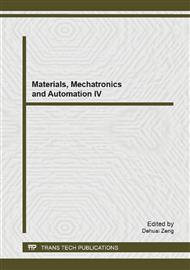[1]
H. Cao, Y, Bai,J. Chen and H. Fang: Control of 2D minimally persistent formations with three co-leaders in a cycle. International Journal of Advanced Robotic Systems. vol. 10(21) (2013), pp.1-7.
DOI: 10.5772/54494
Google Scholar
[2]
H. Cao, Y, Bai and H. Liu: Distributed rigid formation control algorithm for multi-agent systems. Kybernetes. vol. 41(10)(2013), pp.1650-1661.
DOI: 10.1108/03684921211276819
Google Scholar
[3]
R. Olfati-Saber andR. Murray: Distributed cooperative control of multiple vehicle formations using structural potential functions. Proc. of 15th IFAC World Congress (2002).
DOI: 10.3182/20020721-6-es-1901.00244
Google Scholar
[4]
R. Olfati-Saber, W. Dunbar and R. Murray: Cooperative control of multi-vehicle systems using cost graphs and optimization. Proc. of American Control Conference (2003), pp.2217-2222.
DOI: 10.1109/acc.2003.1243403
Google Scholar
[5]
H. G. Tanner, A. Jadbabaie and G. J. Pappas: Stable flocking of mobile agents, part I: fixed topology. Proc. of 42nd IEEE Conference on Decision and Control (2003), p.2010-(2015).
DOI: 10.1109/cdc.2003.1272910
Google Scholar
[6]
H. G. Tanner, A. Jadbabaie and G. J. Pappas: Stable flocking of mobile agents part II: dynamic topology. Proc. of 42nd IEEE Conference on Decision and Control (2003), p.2016-(2021).
DOI: 10.1109/cdc.2003.1272911
Google Scholar
[7]
N. Sorensen and R. Wei: A unified formation control scheme with a single or multiple leaders. Proc. of American Control Conference. ACC '07 (2007), pp.5412-5418.
DOI: 10.1109/acc.2007.4283094
Google Scholar
[8]
L. Krick, M. E. Broucke and B. A. Francis: Stabilization of infinitesimally rigid formations of multi-robot networks. Proc. of 47th IEEE Conference on Decision and Control (2008), pp.477-482.
DOI: 10.1109/cdc.2008.4738760
Google Scholar
[9]
V. Tran andS. Lee: A stable formation control using approximation of translational and angular accelerations. International Journal of Advanced Robotic Systems. vol. 8(1) (2001), pp.65-75.
DOI: 10.5772/10530
Google Scholar
[10]
L. Jiang andR. Zhang: Stable formation control of multi-robot system with communication delay. International Journal of Advanced Robotic Systems. vol. 9(4) (2012).
DOI: 10.5772/45603
Google Scholar
[11]
T. Eren, B. D. O . Anderson and A. S. Morse: Operations on rigid formations of autonomous agents. Communications in Information and Systems. vol. 4(3)(2004), pp.209-219.
Google Scholar
[12]
L. Krick, M. E. Broucke and B. A. Francis: Stabilization of infinitesimally rigid formations of multi-robot networks. Proc. of 47th IEEE Conference on Decision and Control (2008), pp.477-482.
DOI: 10.1109/cdc.2008.4738760
Google Scholar
[13]
T. Tay and W. Whiteley: Generating isostatic frameworks. Structural Topology. vol. 11 (1985), pp.21-69.
Google Scholar
[14]
J. M. Hendrickx, B. D. O. Anderson and V. D. Blondel: Rigidity and persistence of directed graphs. Proc. of 44th IEEE Conference on Decision and Control and 2005 European Control Conference (2005), pp.2176-2181.
DOI: 10.1109/cdc.2005.1582484
Google Scholar
[15]
J. M. Hendrickx, B. D. O. Anderson andJ. Delvenne: Directed graphs for the analysis of rigidity and persistence in autonomous agent systems. International Journal Of Robust And Nonlinear Control. vol. 17(10-11) (2011), pp.960-981.
DOI: 10.1002/rnc.1145
Google Scholar
[16]
J. M, Hendrickx,B. Fidana and C. Yu: Formation reorganization by primitive operations on directed graphs. IEEE Transactions onAutomatic Control. vol. 53(4) (2008), pp.968-979.
DOI: 10.1109/tac.2008.920239
Google Scholar
[17]
C. Yu, B. D. O. Anderson andS. Dasgupta: Control of minimally persistent formations in the plane. Siam Journal On Control And Optimization. vol. 48(1)(2009), pp.206-233.
DOI: 10.1137/060678592
Google Scholar
[18]
P. Tabuada, G. J. Pappas andP. Lima: Cyclic directed formations of multi-agent systems. Proc. of 40th IEEE Conference on Decision and Control (2001), pp.56-61.
DOI: 10.23919/ecc.2001.7075963
Google Scholar
[19]
J. Baillieul and A. Suri: Information patterns and hedging brockett's theorem controlling vehicle formations. Proc. of 42nd IEEE Conference on Decision and Control (2003), pp.556-563.
DOI: 10.1109/cdc.2003.1272622
Google Scholar
[20]
C. Yu, B. D. O. Anderson: Development of redundant rigidity theory for formation control. International Journal of Robust and Nonlinear Control. vol. 19 (13) (2009), p.1427–1446.
DOI: 10.1002/rnc.1386
Google Scholar
[21]
B. Fidan, J. M. Hendricks andB. D. O. Anderson: Closing ranks in rigid multi-agent formations using edge contractions. International Journal of Robust and Nonlinear Control. vol. 20(18) (2010), p.2077–(2092).
DOI: 10.1002/rnc.1570
Google Scholar
[22]
M. Cao,A. S. Morse, C. Yu, B. D. O. Anderson and S. Dasgupta: Maintaining a directed, triangular formation of mobile autonomous agents. Communications in Information and Systems (special issue honoring John Bailleul). vol. 11(1) (2011), pp.1-16.
DOI: 10.4310/cis.2011.v11.n1.a1
Google Scholar
[23]
S. A. Motevallian,C. Yu, and B. D. O. Anderson: Multi-agent rigid formations: a study of robustness to the loss of multiple agents. Proc of IEEE Conference on Decision and Control and European Control Conference (2011), p.3602–3607.
DOI: 10.1109/cdc.2011.6161049
Google Scholar
[24]
J. A. Marshall, M. E. Broucke andB. A. Francis: Formations of vehicles in cyclic pursuit., IEEE Transactions on Automatic Control. vol. 49(11) (2004), p.1963-(1974).
DOI: 10.1109/tac.2004.837589
Google Scholar
[25]
B. D. O. Anderson,C. Yu andS. Dasgupta: Control of a three-coleader formation in the plane. Systems & Control Letters. vol. 56(9-10) (2007), pp.573-578.
DOI: 10.1016/j.sysconle.2007.04.004
Google Scholar


